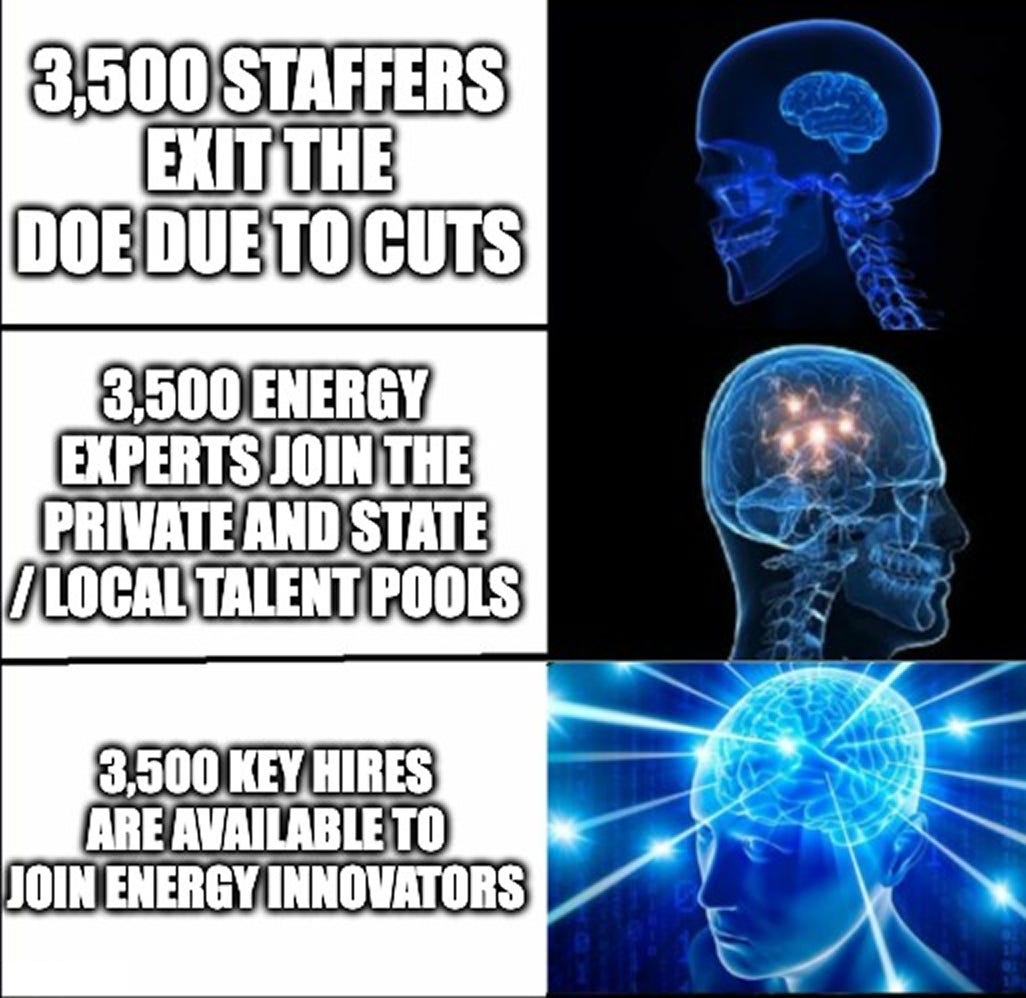Montauk Climate Pulse: Electron Economy Evolution
Incentive shifts, tariff pauses, talent moves, the end of Energy Star, and more.
Welcome to the Montauk Climate Pulse
Welcome to the Montauk Climate Pulse, a regular update from Montauk Climate on key stories we’re tracking in the Electron Economy.
In this edition, we talk about our thoughts on proposed changes to the Inflation Reduction Act (IRA), movements in tariff policy, the end of Energy Star, and DOE / EPA departures. And, in case you get your news via memes these days – don’t worry, we have some of those too.
For more insights from us, make sure to subscribe to the Montauk Climate Substack.
Stories We’re Tracking
Dissecting The One Big, Beautiful Bill
The brief
The One Big, Beautiful Bill has passed in the House and is now in the Senate. Notably, the bill introduces rollbacks to tax credits and tax credit transferability benefits introduced or expanded upon under the IRA. A full summary of changes to IRA-led benefits can be found here.
Our key takeaways
Speed matters more than ever.
Across all projects and technologies within the Electron Economy, potential exits of incentives underscore the importance of speed in infrastructure development. Considering that many credit rollbacks are planned phase-outs over a number of years, developers will need to achieve high speed of execution in order to maximize their incentive exposure. Speed has always mattered, but it becomes paramount given these developments.
With potential cuts in public financing come opportunities for the private market to fill funding gaps.
Utility-Scale: Clean energy credits expire for all projects placed in service after 2029. While this may seem like sufficient time to get projects live, that may not be the case. To get a project placed in service, interconnection is required — thus, a long interconnection queue could delay projects from taking advantage of incentives. Private credit providers can step in to offer bridge financing that can help developers get projects placed in service faster and maximize their tax credit earnings.
Commercial & Industrial: If on-site generation becomes less attractive due to sunsetting incentives, it may become a less viable solution for energy consumers. This opens the door for enterprises to substitute generation investments with efficiency investments to get more out of the same energy inflow without adding new watts to the system. Enterprise interest will turn toward application-layer platforms that can drive efficiency without major capital investment or infrastructure overhaul. Clear Current, our incubation building the central nervous system for energy management, exemplifies this type of solution.
Residential: Historically, incentives for home electrification have reduced upfront costs and acted as powerful marketing tools to enable word-of-mouth adoption. Today, with rising energy prices and sunsetting incentives, homeowner savings is the North Star of residential energy solutions. Successful solutions need to deliver customers substantial savings and home energy efficiencies to make adoption and word-of-mouth advocacy a “no-brainer.” The market is poised to reward these innovations presenting homeowners with incentive-independent ROI. At Montauk Climate, as we consider private credit investments via Turtle Hill Capital, we continue to rigorously evaluate new residential electrification opportunities with this shift in mind, grounding our assessments in real market and customer feedback.
Changes in incentives shift trends in the deployment of energy technology.
Nuclear Sees Material Tailwinds. More-moderate changes to nuclear incentives (Zero-Emission Nuclear Power Production Credit left untouched until 2031) reinforce bipartisan efforts to accelerate the US’ nuclear energy generation Renaissance. That said, no clean electricity investment or production credits will be issued for advanced nuclear facilities with construction dates beginning after 2028. This could be a forcing function for projects to break ground faster in order to take advantage. However, considering that the NRC is overburdened, clean electricity credits could expire before developers are able to do so. Changes to the NRC along with external pressure on the agency may help accelerate approvals, but maintaining rigorous safety standards will remain essential to ensure that any acceleration is not achieved at the expense of risk management.
Hydrogen Remains Challenged Commercially & Subsidized. Clean hydrogen credits have been sunset for all projects breaking ground after EOY 2025, making economics for clean hydrogen even more challenging. Developers might continue to pursue blue hydrogen opportunities in the near-term while taking advantage of carbon sequestration credits to minimize emissions.
US and China agree to pause sky-high tariffs for 90 days
The brief
The U.S. and China agreed to a 90-day pause in their escalating trade war, significantly reducing tariffs imposed earlier this year for the time-being. These paused tariffs alone reduce the negative economic impact of all 2025 tariffs to date by 40%.
Our analysis
Relief may be encouraging, but this pause may not be permanent. A potential re-escalation after 90 days continues to complicate long-term infrastructure planning, especially for energy storage developers that rely on materials and components sourced from China. Given the uncertainty created by these tariff changes, companies focused on planning ahead and hedging against risk will be able to stand out and win. Thus, solutions that can unlock agile planning like Euclid Power that help teams hedge and adapt are essential to ensuring that teams can adapt more rapidly in the face of changing circumstances.
Energy Star is ending
The brief
The Energy Star program – a longstanding energy efficiency resource for homeowners and businesses allowing them to find efficient appliances – is now coming to an end. Per the EPA, the Energy Star program is a massive savings unlock for Americans: the program has contributed to $500B in household and business energy savings since the program’s launch.
Our analysis
While this is a major setback for standardized energy efficiency labelling for appliances, this might shift value and interest toward orchestration layers like VPPs and DERs that can coordinate energy assets for greater efficiency and cost savings. As attention shifts toward these types of efficiency gains, distributed energy plays like Haven and Shyft Power Solutions could experience tailwinds.
Talent Shifts in Energy
The brief
As 3,500 staffers leave the Energy Department and over 1,000 staffers leave the EPA, numerous talented energy and climate experts enter the private and public sector job markets in the domain.
Our analysis
This could be a pivotal talent unlock for early-stage climate companies and state / local energy organizations looking for top-tier talent with understandings of how the pie is baked.
On the Montauk side, we’re always excited to connect with great talent interested in building with us or joining one of our portfolio companies. We’re building for the Electron Economy along the following investment themes: Energy Abundance, Resilience, and Efficiency. Reach out to us here, and more information about our portfolio companies can be found here.
Deals We’re Tracking
GridCARE
About the company: GridCARE uses AI to help data centers connect to power, faster. By using generative AI to pinpoint and develop optimal sites for data center development, GridCARE reduces time-to-power from years to months via software.
Deal details: $13.5M Seed – led by Xora (Temasek deeptech), with participation from Breakthrough Energy Discovery, Clocktower Ventures, Overture Ventures, and WovenEarth.
Why we’re tracking this: The queue of data centers seeking grid connection continues to grow, bloating time-to-operations via longer connection wait times. At the same time, utilities need more information to pursue data center-driven load growth. A scalable application-layer solution has potential to address both developers’ and utilities’ pain points.
Atomic Canyon
About the company: Atomic Canyon is building the first AI-powered solution for nuclear data, using the NRC’s database to modernize operations in the nuclear energy sector. They are currently working on the first commercial deployment of on-site generative AI at a U.S. nuclear power plant.
Deal details: $7M Seed round led by Energy Impact Partners, with participation from Commonweal Ventures, Wischoff Ventures, and more.
Why we’re tracking this: As energy demand increases, solutions to modernize existing nuclear assets can make nuclear energy generation more efficient and make nuclear energy a clearer option to meet energy consumers’ needs.
Nira Energy
About the company: Nira Energy offers a cloud-based software platform that simplifies and accelerates transmission interconnection and planning for energy generation, energy storage, and data centers.
Deal details: Energize Capital announced a strategic growth investment.
Why we’re tracking this: A growth investment in another application-layer solution for interconnection demonstrates greater interest in fighting interconnection delays, setting foundations for faster project developments.
5 (Energy Advisory Firm)
About the company: 5 is a tech-enabled energy advisory firm serving commercial and industrial customers across North America, aiding large industrial, commercial and public sector companies with power procurement, risk management, sustainability, compliance, and incentives.
Deal details: Energize Capital acquired 10% of 5 via a growth / expansion round.
Why we’re tracking this: For many commercial and industrial customers, a human-in-the-loop tech-enabled advisory business seems apt to fulfill business needs within energy while maintaining advantageous ways of working.
CPower
About the company: CPower is a demand-side energy management company that helps commercial, industrial, and institutional clients monetize distributed energy resources (DERs) by integrating them into virtual power plants (VPPs) to support grid reliability and participate in energy markets.
Deal details: NRG acquired CPower from LS Power.
Why we’re tracking this: This is a strategic acquisition by NRG, allowing them to capitalize on growing needs for grid flexibility and resilience and offer new services for B2B and B2C customers that help maintain cheap and reliable electricity service in a more distributed energy landscape.
What We’re Building
Clear Current
Clear Current announced a $4M+ Seed round, with participation from Rho Ignition, Coreline Ventures, and Avesta Fund participating. Read more via ImpactAlpha, and you can reach out to the team here to learn more.
GridFree AI
Gridfree AI exited stealth with $5 million in funding – led by Giant Ventures, with participation from Amplo. Read more via Axios, and you can reach out to the team here to learn more.
Want to learn more about Montauk Climate? Connect with us here.







